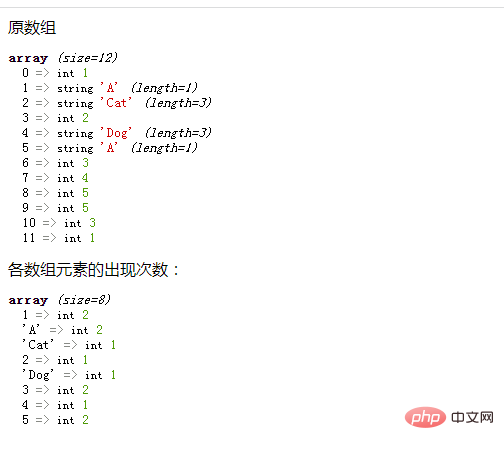How to extract unique values from an array in php
Extraction steps: 1. Use the array_count_values() function to count the number of occurrences of elements in the array. The syntax "array_count_values (original array)" will return an associative array whose key name is the value of the original array. The key value is the number of times the value appears in the original array; 2. Use the array_keys() function to obtain the element with the number of occurrences 1, that is, extract the key name of the element with the key value 1 in the associative array, the syntax "array_keys(associative array ,1)".

The operating environment of this tutorial: windows7 system, PHP version 8.1, DELL G3 computer
In PHP, you can use the array_count_values() function and array_keys() function to extract unique values in the array.
Implementation steps:
Step 1: Use the array_count_values() function to count the number of occurrences of elements in the array
array_count_values( ) function can count the number of occurrences of all values in the array; will return an associative array, the key name of its element is the value of the original array, and the key value is the number of times the value appears in the original array .
<?php header('content-type:text/html;charset=utf-8'); $arr=array(1,"A","Cat",2,"Dog","A",3,4,5,5,3,1); echo "原数组"; var_dump($arr); $con=array_count_values($arr); echo "各数组元素的出现次数:"; var_dump($con); ?>

Step 2: Use the array_keys() function to extract unique values in the array
Values with a count of 1, Just don't repeat the value.
Just use the array_keys() function to get the key name corresponding to the element with a key value of 1 in the returned associative array.
<?php header('content-type:text/html;charset=utf-8'); $arr=array(1,"A","Cat",2,"Dog","A",3,4,5,5,3,1); echo "原数组"; var_dump($arr); $con=array_count_values($arr); echo "各数组元素的出现次数:"; var_dump($con); $res=array_keys($con,1); echo "数组中的不重复值:"; var_dump($res); ?>

Description:
array_key() function can get some or all key names in the array
array_keys($array [, $search_value = null [, $strict = false]])
Parameter description is as follows:
- $array: required parameter, which is the array to be operated;
- $search_value: optional parameter, if the parameter is empty, the function will return the array All key names in, if this parameter is specified, the function will only return the key name with the value $search_value;
- $strict: Optional parameter to determine whether to use strict mode when searching, $ strict defaults to false, which is non-strict mode. When searching, only types are compared, not types. If $strict is set to true, which is strict mode, values and types are compared at the same time during search, which is equivalent to
===.
array_keys() function will return the obtained array key name in the form of an array.
Recommended learning: "PHP Video Tutorial"
The above is the detailed content of How to extract unique values from an array in php. For more information, please follow other related articles on the PHP Chinese website!

Hot AI Tools

Undresser.AI Undress
AI-powered app for creating realistic nude photos

AI Clothes Remover
Online AI tool for removing clothes from photos.

Undress AI Tool
Undress images for free

Clothoff.io
AI clothes remover

Video Face Swap
Swap faces in any video effortlessly with our completely free AI face swap tool!

Hot Article

Hot Tools

Notepad++7.3.1
Easy-to-use and free code editor

SublimeText3 Chinese version
Chinese version, very easy to use

Zend Studio 13.0.1
Powerful PHP integrated development environment

Dreamweaver CS6
Visual web development tools

SublimeText3 Mac version
God-level code editing software (SublimeText3)

Hot Topics
 1677
1677
 14
14
 1431
1431
 52
52
 1334
1334
 25
25
 1280
1280
 29
29
 1257
1257
 24
24
 What happens if session_start() is called multiple times?
Apr 25, 2025 am 12:06 AM
What happens if session_start() is called multiple times?
Apr 25, 2025 am 12:06 AM
Multiple calls to session_start() will result in warning messages and possible data overwrites. 1) PHP will issue a warning, prompting that the session has been started. 2) It may cause unexpected overwriting of session data. 3) Use session_status() to check the session status to avoid repeated calls.
 What is the significance of the session_start() function?
May 03, 2025 am 12:18 AM
What is the significance of the session_start() function?
May 03, 2025 am 12:18 AM
session_start()iscrucialinPHPformanagingusersessions.1)Itinitiatesanewsessionifnoneexists,2)resumesanexistingsession,and3)setsasessioncookieforcontinuityacrossrequests,enablingapplicationslikeuserauthenticationandpersonalizedcontent.
 Composer: Aiding PHP Development Through AI
Apr 29, 2025 am 12:27 AM
Composer: Aiding PHP Development Through AI
Apr 29, 2025 am 12:27 AM
AI can help optimize the use of Composer. Specific methods include: 1. Dependency management optimization: AI analyzes dependencies, recommends the best version combination, and reduces conflicts. 2. Automated code generation: AI generates composer.json files that conform to best practices. 3. Improve code quality: AI detects potential problems, provides optimization suggestions, and improves code quality. These methods are implemented through machine learning and natural language processing technologies to help developers improve efficiency and code quality.
 How to use MySQL functions for data processing and calculation
Apr 29, 2025 pm 04:21 PM
How to use MySQL functions for data processing and calculation
Apr 29, 2025 pm 04:21 PM
MySQL functions can be used for data processing and calculation. 1. Basic usage includes string processing, date calculation and mathematical operations. 2. Advanced usage involves combining multiple functions to implement complex operations. 3. Performance optimization requires avoiding the use of functions in the WHERE clause and using GROUPBY and temporary tables.
 H5: Key Improvements in HTML5
Apr 28, 2025 am 12:26 AM
H5: Key Improvements in HTML5
Apr 28, 2025 am 12:26 AM
HTML5 brings five key improvements: 1. Semantic tags improve code clarity and SEO effects; 2. Multimedia support simplifies video and audio embedding; 3. Form enhancement simplifies verification; 4. Offline and local storage improves user experience; 5. Canvas and graphics functions enhance the visualization of web pages.
 Composer: The Package Manager for PHP Developers
May 02, 2025 am 12:23 AM
Composer: The Package Manager for PHP Developers
May 02, 2025 am 12:23 AM
Composer is a dependency management tool for PHP, and manages project dependencies through composer.json file. 1) parse composer.json to obtain dependency information; 2) parse dependencies to form a dependency tree; 3) download and install dependencies from Packagist to the vendor directory; 4) generate composer.lock file to lock the dependency version to ensure team consistency and project maintainability.
 How to use type traits in C?
Apr 28, 2025 pm 08:18 PM
How to use type traits in C?
Apr 28, 2025 pm 08:18 PM
typetraits are used in C for compile-time type checking and operation, improving code flexibility and type safety. 1) Type judgment is performed through std::is_integral and std::is_floating_point to achieve efficient type checking and output. 2) Use std::is_trivially_copyable to optimize vector copy and select different copy strategies according to the type. 3) Pay attention to compile-time decision-making, type safety, performance optimization and code complexity. Reasonable use of typetraits can greatly improve code quality.
 How to configure the character set and collation rules of MySQL
Apr 29, 2025 pm 04:06 PM
How to configure the character set and collation rules of MySQL
Apr 29, 2025 pm 04:06 PM
Methods for configuring character sets and collations in MySQL include: 1. Setting the character sets and collations at the server level: SETNAMES'utf8'; SETCHARACTERSETutf8; SETCOLLATION_CONNECTION='utf8_general_ci'; 2. Create a database that uses specific character sets and collations: CREATEDATABASEexample_dbCHARACTERSETutf8COLLATEutf8_general_ci; 3. Specify character sets and collations when creating a table: CREATETABLEexample_table(idINT




